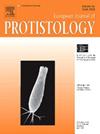Exploring the diversity of Brachonella: Morphological and molecular analysis with the discovery of a new species, Brachonella tenuicauda nov. spec. (Ciliophora, Armophorea, Metopida)
IF 1.6
2区 生物学
Q4 MICROBIOLOGY
引用次数: 0
Abstract
Recently, the interest in studying anaerobic ciliates, particularly armophorean ciliates of the family Metopidae, has increased. The genus Brachonella, a member of this family, currently comprises eight species. However, only four of them have been comprehensively described, with B. contorta, the type species of Brachonella, being the subject of extensive global distribution analyses. This study presents a comprehensive morphological and molecular phylogenetic analysis of B. tenuicauda nov. spec., B. elongata, and B. pulchra. Brachonella tenuicauda is characterized by a tail-like posterior body end and by clusters of two to four dikinetids in the preoral dome kineties. Brachonella elongata is identified by its slender, elongated body without posterior constriction, whereas B. pulchra shows a broadly ellipsoidal to nearly obovoid body. Korean populations of B. pulchra and B. tenuicauda exhibit a diplostichomonad paroral membrane, a feature not previously documented for this genus. Phylogenetic analysis of 18S rDNA sequences indicates non-monophyly of the family Metopidae. Conversely, the genus Brachonella is depicted as monophyletic with full support, confirming its molecular distinctness from other metopid genera.
探索 Brachonella 的多样性:通过形态学和分子分析发现新物种 Brachonella tenuicauda nov.(纤毛虫纲,腕足动物,甲壳纲)
近年来,人们对厌氧纤毛虫,特别是甲足科的纤毛虫的研究兴趣日益浓厚。作为这一科的一员,布氏菌属目前有8个种。然而,其中只有四种已被全面描述,与B. contorta,布拉氏菌的模式种,是广泛的全球分布分析的主题。本文对细尾白鲟、长尾白鲟和pulchra白鲟进行了全面的形态和分子系统发育分析。细纹短臂杆菌的特征是体后端呈尾状,口前穹隆运动中有2 - 4个双胞体。长臂杆菌的体细长,无后缩,而短臂杆菌的体宽椭球形至近倒卵形。朝鲜种群的pulchra B.和tenuicauda B.表现出一种口旁膜,这一特征以前未在该属中有记载。18S rDNA序列的系统发育分析表明,甲螨科属非单系。相反,短臂杆菌属被描述为具有完全支持的单系,证实了其与其他类甲属的分子独特性。
本文章由计算机程序翻译,如有差异,请以英文原文为准。
求助全文
约1分钟内获得全文
求助全文
来源期刊

European journal of protistology
生物-微生物学
CiteScore
4.60
自引率
20.70%
发文量
55
审稿时长
14.6 weeks
期刊介绍:
Articles deal with protists, unicellular organisms encountered free-living in various habitats or as parasites or used in basic research or applications. The European Journal of Protistology covers topics such as the structure and systematics of protists, their development, ecology, molecular biology and physiology. Beside publishing original articles the journal offers a forum for announcing scientific meetings. Reviews of recently published books are included as well. With its diversity of topics, the European Journal of Protistology is an essential source of information for every active protistologist and for biologists of various fields.
 求助内容:
求助内容: 应助结果提醒方式:
应助结果提醒方式:


